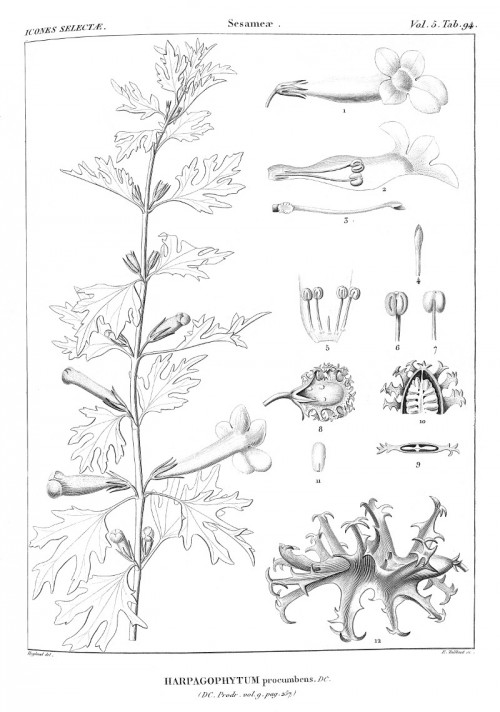Harpagophytum procumbens (Burch.) DC. ex Meisn. - syn.Uncaria procumbens Burch. - Pedaliaceae - devil's claw, wood spider, grapple plant, Teufelskralle
Perennial herb, native to southern Africa; taproot succulent; stems annual, creeping, up to 2m long; leaves opposite, simple, deeply or shallowly lobed; flowers tubular, 5-6cm long, pale purple or pink, sometimes white, yellow inside the tube; fruits large (up to 15cm in diam.), forming curved arms with recurved spines; seeds dark brown or black.
There are two subspecies of H. procumbens, namely H. procumbens subsp. procumbens (leaves with five main lobes, spiny arms on the fruits two to five times wider than the width of the middle of the fruit), found in Botswana, Namibia and South Africa; and H. procumbens subsp. transvaalense (leaves with only three main lobes, fruits with shorter spiny arms) found in Zimbabwe and South Africa.
Devil's claw is difficult to grow in cultivation. The most of the tubers used for Western medicine come from plants growing in the wild. „Wild-harvesting of devil’s claw tubers can be sustainable if only some of the tubers are taken and if enough are left behind for the plants to regenerate.“
http://www.kew.org/science-conservation/plants-fungi/harpagophytum-procumbens-devils-claw
The sliced and dried secondary roots (devils claw root, Harpagophyti radix) are used as bitter tonic, anti-inflammatory, anti-rheumatic, and weak analgesic. „ Iridoid glycosides (or their metabolties) inhibit cyclooxygenase, which explains the slight analgesic and anti-inflammatory activity. The bitter taste (and possibly the value in treating digestive disturbances) is due to the iridoid glycosides.“
[Medicinal Plants of the World. Ben-Erik Van Wyk and Michael Wink, Pretoria 2004, 165]
„However, some reports on the anti-inflammatory effect of H. procumbens extracts are inconsistent, and differences had widely been attributed to the extraction procedure, geographical source of the crude drug and the fractions of constituents. The inhibitory effect on COX-2 expression was determined for an ethanol extract of H. procumbens tubers and its major active components, harpagoside, harpagide, 8-p-coumaroylharpagide and acteoside, following application to freshly excised porcine skin. The extract showed promising activity in the Western blot and immunocytochemical assays, and harpagide caused a significant increase in the levels of COX-2 expression 6 h post application. Harpagoside and 8-p-coumaroylharpagide caused greater reductions in COX-2 expression than acteoside. Results indicated that the efficacy of H. procumbens was dependent on the ratios of the four major active compounds present. This is not congruent with the current official monograph specifications based solely on harpagoside…
Iridoid glycosides and phenylpropanoid glycosides have been the focus of phytochemical investigations as the biological activity has been ascribed to the iridoid glycosides (such as harpagoside and harpagide), which are common in nature and are known to possess anti-inflammatory activity. In addition, it has been shown that the hydrolysed products of harpagoside and harpagide have more pronounced anti-inflammatory activity when compared to the unhydrolysed compounds.“
[Devil's Claw-A review of the ethnobotany, phytochemistry and biological activity of Harpagophytum procumbens., Mncwangi, N., Chen, W., Vermaak, I., Viljoen, A.M., Gericke, N., Journal of ethnopharmacology, 143(3), 2012, 755-771]
An extract of the roots (60% v/v ethanol, sole active ingredient of Pascoe®-Agil) dose-dependently inhibited the release of TNFα and of interleukin (IL)-6, IL-1β as well as prostaglandin E2 (PGE2), prevented TNFα and IL-6 mRNA expression in human monocytes and cyclooxygenase-2 (COX-2) in RAW 264.7 cells. Furthermore, the extract inhibited LPS-stimulated AP-1-mediated gene transcription activity and binding to the AP-1 response elements. „The data indicate that a standardized ethanol Hp extract inhibits induction of pro-inflammatory gene expression, possibly by blocking the AP-1 pathway. This is novel evidence of a possible mechanism of action of this antiinflammatory drug.“
[Molecular Targets of the Antiinflammatory Harpagophytum procumbens (Devil's claw): Inhibition of TNFα and COX‐2 Gene Expression by Preventing Activation of AP‐1., Fiebich, B.L., Muñoz, E., Rose, T., Weiss, G., McGregor, G.P., Phytotherapy Research, 26(6), 2012, 806-811] http://www.pascoe.ca/wp-content/uploads/2014/07/Fiebich-PhytotherRes-2011-Harpagophytum-TNF-alpha.pdf
„Harpagophytum procumbens (devil's claw, DC) dose-dependently suppressed the release of TNF-α, IL-6 and IL-8 in LPS-stimulated monocytic THP-1 cells at non-cytotoxic concentrations (50–250 μg/ml). The metabolic activation of the DC extract by S9 mix did not alternate its cytotoxicity and did not diminish its inhibitory effect. This effect was improved in the case of TNF-α inhibition as reflected by their EC50 values of 116 ± 8.2 μg/ml and 49 ± 3.5 μg/ml for DC and DCm (P < 0.01)… Cytokines inhibitory activity of DC was not affected after its external metabolic activation. However, the amount of harpagoside and caffeic acid derivates was decreased. Other components of the extract might have contributed to its anti-inflammatory effect.“
[Alteration of anti‐inflammatory activity of Harpagophytum procumbens (devil's claw) extract after external metabolic activation with S9 mix., Hostanska, K., Melzer, J., Rostock, M., Suter, A., Saller, R., Journal of Pharmacy and Pharmacology, 66(11), 2014, 1606-1614]

Delessert, B., de Candolle, A.P., Icones selectae plantarum, vol.5 t.94 (1846)
http://plantgenera.org/species.php?id_species=494290
